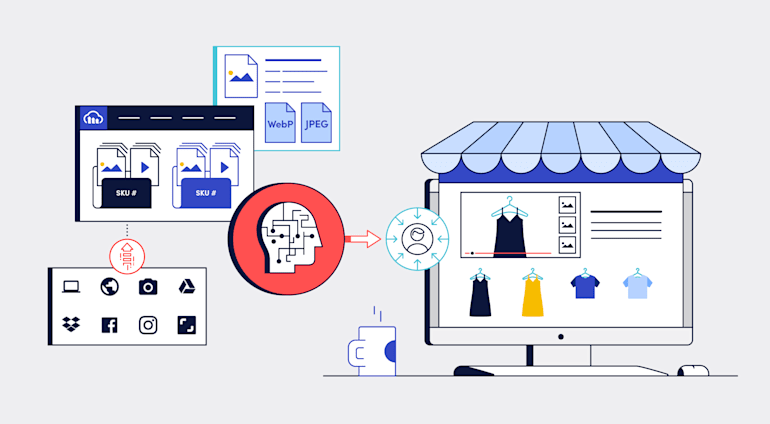During this months-long COVID-19 pandemic, which of us have not made purchases online? In particular, early on during the lockdown, when only essential businesses were open, the web was the primary shopping outlet. Accordingly, we as consumers have come to learn how varied retailers and brands are in e-commerce savvy.
Data from IBM’s U.S. Retail Index suggests that this year’s pandemic-caused disruption has accelerated the shift from physical to digital commerce by nearly five years. For businesses not prepared for such a drastic change, building and maintaining a virtual shop has felt like being thrown into the deep end of a pool with no swimming skills.
To help retailers and brands tread e-commerce waters and those endeavoring to stay competitive, our annual conference this year, ImageCon 2020, Ariel Shiran and I, Naveen Prasanna, were featured in a session titled Bringing Virtual Shops to Life, which delved into the ways technology can enliven e-commerce sites by streamlining the creation for and delivery of visual content.
Below is the video and a recap of the session.
The Importance of Consistency in Customer Experience
Rich media have long been critical for e-commerce. The many adjustments made to our day-to-day e-commerce experiences as a result of the pandemic closures have emphasized the need for high-quality visuals for online retail, especially to enable shoppers to explore products in detail almost as well as they could in person.
A study has found that 79 percent of customers are unlikely to buy again after an unpleasant experience. Also, as page-load time rises from one second to three seconds, the probability of bounce increases by 32 percent; and 53 percent of visitors abandon a mobile site that takes more than three seconds to load.
Consistency is, therefore, absolutely crucial. Right off the bat, online content must be engaging and must load quickly. As well, we’re more inclined to make purchases if the content is personalized to our preferences, size, and lifestyle. Underscoring all those requirements is the need for businesses to scale in the types of content on e-commerce platforms and in the number of viewers for whom the content is tailored—and even personalized.
Must-Have Features, From Photoshoot to Product Launch
Nowadays, developers, IT, and content-creation teams must be agile in their strife to deliver the visual experiences online shoppers crave for. A number of professionals, ranging between three to 300, are involved in the creation process, both internally and externally through third-party resources. A catalog of 5,000 products, each of which spotlighted by four images and a video, would require 20,000 media assets. The addition of hundreds of seasonal products would lead to a staggering volume. So, in the face of the COVID-induced digital reality, e-commerce businesses must speed up the whole publication process.
The ImageCon2020 session mentioned above contains a thorough digital asset management (DAM) demo that showcases Cloudinary’s media-first capabilities and the ways in which retailers and brands can create and publish at the speed today’s competitive e-commerce landscape mandates. Here’s a quick rundown of the process:
- Upload assets from various sources, transforming them as you do so. You can upload to Cloudinary assets from any source: Google Drive, Dropbox, Facebook, Instagram, Shutterstock, after which photographers, designers, and other experts can immediately start collaborating with one another. Note that, besides enabling fast uploads, Cloudinary’s automated tagging, resizing, background removal, and other transformation capabilities can apply your business rules to make instantaneous, sweeping edits to your media,.
- Automate structured metadata for attributes you’ll need to cull quickly down the road. Cloudinary’s DAM defines specific attributes for images, such as product IDs and color options, so as to auto-tag those images for e-commerce characteristics through artificial intelligence (AI). Afterwards, your assets become readily searchable for immediate use in product pages, marketing material, and digital ads.
Manage the imagery for product catalogs boasting countless SKUs by integrating with Cloudinary’s Magento extension or with Salesforce Commerce Cloud, Shopify, and other e-commerce platforms. For e-commerce sites built on Magento, Cloudinary offers an Add from Cloudinary option in the Magento admin UI. After choosing that option, businesses can pick assets directly from the Cloudinary DAM to associate with new products and product pages. Subsequently, two more clicks (Save followed by Publish) would update the storefront.
This step illustrates where Cloudinary shines by affording tech-stack users the invaluable benefits of automated operations, including formatting and optimization.
Integrate Cloudinary with a content management system (CMS) like WordPress for customization of targeted marketing content. Let’s say you want to create two regional pages for a product release, one for San Francisco and the other for Barcelona, each with its unique cityscape and language. Taking the customized content live to the e-commerce site is effortless, thanks to Cloudinary’s APIs and the already-uploaded and transformed Photoshop files. What’s more, Cloudinary runs sophisticated algorithms behind the scenes to figure out, based on the content of your imagery, the best format, e.g., a JPEG or WebP, to adopt for the user’s browser.
Cloudinary performs all those nuanced tasks on the fly, saving e-commerce businesses a load of time and effort.
Cloudinary’s Dynamic Media Platform: a Potent Driving Force for E-commerce Success
From managing media (photos, videos, 360-degree spin sets, 3D objects) for product catalogs to delivering personalized and innovative experiences to an increasingly visual domain, Cloudinary has the solutions e-commerce brands need. Plus, with Cloudinary’s AI-enabled scalability, which applies throughout the process, and integrations with the tools you’re using, you can deliver consistent and captivating e-commerce experiences, time and time again. View this session and more at Cloudinary.com/imagecon.





